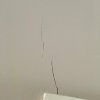- Joined
- 14 Sep 2016
- Messages
- 11
- Reaction score
- 0
- Country

I purchased a property a few months ago that had an internal garage knocked through to extend a lounge. This involves removing a load bearing wall and installing an RSJ. The work was completed four years ago and has a buildings regulation completion certificate.
When purchasing the property I was led to believe this should remove any doubt over the structural integrity of the house and no structural survey is needed (the house is only 15 years old).
However, after living in it for a few months there are a few things that concern me:
1. I've noticed a couple of cracks, max 1mm thick and between 10 and 15 centre meters long, coming from the doorframe on the floor above where the work was completed.
2. Doors on the floor above perpendicular to where the wall was knocked through are stiff to open
3. Doors on floor above parallel to where the wall was knocked through don't meet up with door frame perfectly
4. Floor boards around where work was done are very creaky!
I was just wondering if anyone had any experience with this and whether I should be worried? I'm considering getting a structural engineer in to take a look and ease any fears I have, but wanted to make sure I wasn't worrying over nothing...
When purchasing the property I was led to believe this should remove any doubt over the structural integrity of the house and no structural survey is needed (the house is only 15 years old).
However, after living in it for a few months there are a few things that concern me:
1. I've noticed a couple of cracks, max 1mm thick and between 10 and 15 centre meters long, coming from the doorframe on the floor above where the work was completed.
2. Doors on the floor above perpendicular to where the wall was knocked through are stiff to open
3. Doors on floor above parallel to where the wall was knocked through don't meet up with door frame perfectly
4. Floor boards around where work was done are very creaky!
I was just wondering if anyone had any experience with this and whether I should be worried? I'm considering getting a structural engineer in to take a look and ease any fears I have, but wanted to make sure I wasn't worrying over nothing...

